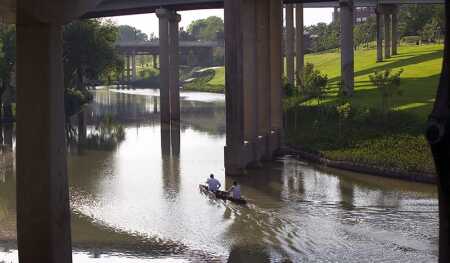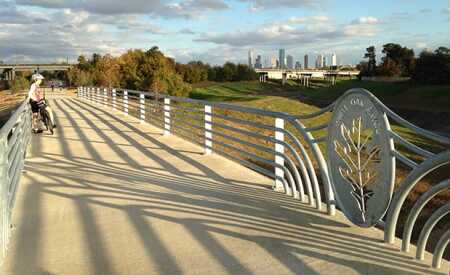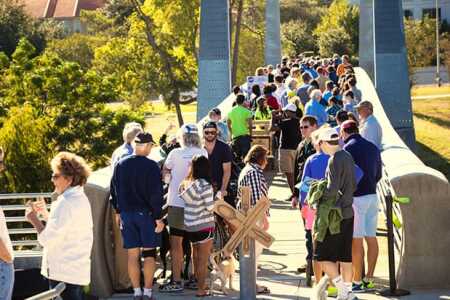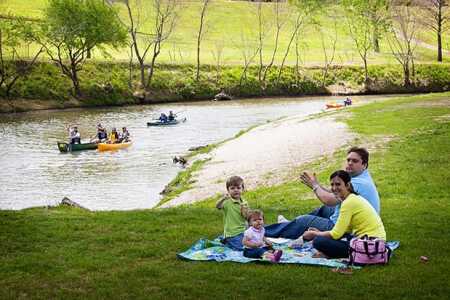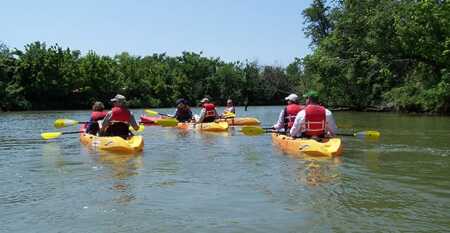In 2015, ULI hosted its annual Spring Meeting in Houston to great success. Following the devastation of Hurricane Harvey, we are republishing a selection of articles focusing on the city’s growth and resilience as it faces the future and recovery. We encourage you to give generously to the many organizations providing first-response efforts.
Across the United States, a number of cities are attempting to restore and rediscover their urban rivers. In New York City, the once-blighted Bronx River is being cleaned up and its coast revamped with greenbelts, bike paths, and playgrounds. On the opposite coast, Los Angeles has proposed transforming its long-neglected river channel into a green spine with parks, trails, and even boating activities. In between the coasts, Austin, Texas, wants to develop an unbroken greenway along Waller Creek, and Grand Rapids, Michigan, planners hope to remove dams in the downtown river to restore the city’s namesake waterway.
But one of the largest and most ambitious efforts is occurring in Houston, where the waterways are called bayous. There, Buffalo Bayou Park near downtown is undergoing a $58 million redevelopment, scheduled to be completed this year, that is adding trails, perennial gardens, public art, entertainment pavilions, dog parks, and acres of new natural landscaping.
And on a grander scale, the Bayou Greenways 2020 initiative has started a seven-year program to connect linear parks for 150 miles (241 km) along nine bayous within the city limits. With an estimated $220 million price tag, the Greenways project is the largest park-building initiative in the city’s history and could become—if eventually connected with the suburbs—the country’s largest urban trail system.
“Historically, we’re in an unparalleled period right now in the attention being paid to urban rivers,” says Adrian Benepe, director of city park development for the Trust for Public Land, a San Francisco–based nonprofit organization that promotes and creates parks. “Houston is very much in the lead in this, and its projects are so large-scale and ambitious [that] you can only compare them to the planning in the 19th century, when cities first established their park systems.”
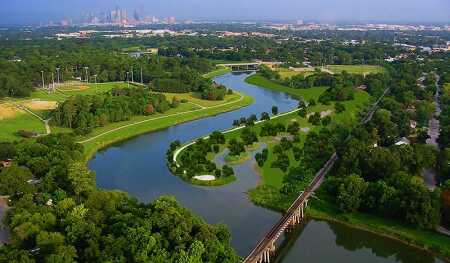
Houston’s rivers and streams are called bayous because the waters are slow and meandering. Ten major natural bayous cross the city. The Houston Parks Board’s Bayou Greenways 2020 project intends to develop and connect linear parks along most of these bayous, so residents can enjoy walking, biking, and playing beside them. (Houston Parks Board)
In Houston, the rivers are called bayous because they feature a slow, meandering, and murky current. In a city without mountains, oceans, or other distinctive topography, the bayous are the distinguishing natural feature of Houston and inspire its nickname—Bayou City.
The bayou redevelopments, propelled by public/private partnerships and historic levels of voter and philanthropic support, are intended to promote urban livability, enhance the quality of life, and provide a competitive advantage among other major U.S. metropolitan areas. Already, the projects are attracting new real estate development.
The 18-story Park Place at Buffalo Bayou office building, developed by Houston-based Pinto Realty Partners, is under construction, designed to contain 250,000 square feet (23,000 sq m) of high-end office space while offering a fitness center and locker rooms for tenants who want to jog or hike at Buffalo Bayou Park across the street. It is the first office building in a growing residential corridor near downtown, says Michael Anderson, executive vice president of Colvill Office Properties, which is leasing the building.
“It’s the start of the restoration of this area, and it’s the park that’s spurring all this,” Anderson says. “The redevelopment of the bayou is a major selling point. It’s creating a destination.”
Other new projects now tout their views of Buffalo Bayou Park. One longtime Houston homebuilder, Sims Luxury Builders, is embarking on its first multifamily project, Riva at the Park, a seven-story, 22-unit condo project near Buffalo Bayou Park. It is slated to open in 2016 and advertises picture-window and balcony views of the park. A planned 40-story mixed-use residential and retail high rise in downtown called Market Square Tower also advertises “panoramic views” of the park.
“This city has awakened the potential of the bayous as a way to create development and to further densify and urbanize the city,” says Ed Wulfe, chief executive officer of a shopping center development firm in Houston and an early champion of the bayou redevelopments, as well as a past chairman of ULI Houston. “They’re amenities waiting to be capitalized on.”
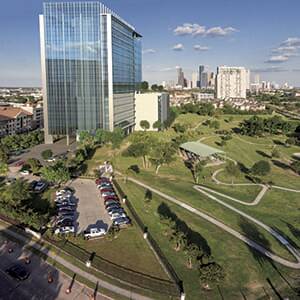
The redevelopment of Buffalo Bayou Park near downtown Houston is already attracting new real estate projects that advertise their proximity to the park. One such project is the 18-story Park Place at Buffalo Bayou office building, which is under construction adjacent to one park and across a thoroughfare from Buffalo Bayou Park. (Kirksey Architecture)
Reinvention
In real estate and city planning, Houston is perhaps best known as the largest U.S. city without zoning. Essentially, the city relies on the market to dictate development patterns within its 600 square miles (1,500 sq km). But since the turn of the century, municipal leaders have taken a series of proactive steps to take advantage of the growing interest in urban living. Among other things, the city built new stadiums (NRG Stadium and Toyota Arena) and a performing arts venue (Hobby Center for Performing Arts) downtown, created a downtown park (Discovery Green), transformed Market Square Park, opened and expanded a light-rail system, adopted a complete-streets policy—which calls for multimodal considerations such as wider sidewalks and bike lanes for city street improvements—and now is developing the bayou parks.
“This is a city reinventing itself,” says Steve Klineberg, codirector of Rice University’s Kinder Institute for Urban Research, a sociocultural research center in Houston that is also supported by local philanthropists Nancy and Rich Kinder, who have been major contributors to the bayou effort. “These were ideas that had no traction ten to 15 years ago, and now they’re central to Houston re-creating itself and recognizing that what it needs to be prosperous requires a new way of thinking.”
In the case of the bayous, this recognition has been a long time coming.
As with many cities, Houston’s founding was based on its proximity to water. The city’s original docks were established at the foot of Main Street at the confluence of Buffalo and White Oak bayous. But for much of the last century, Houston ignored and squandered these waterways.
“Traditionally, we mostly turned our backs on them,” says David Crossley, president of Houston Tomorrow, a group that promotes quality-of-life planning.
For decades before and after World War II, flood-control engineers treated the bayous as drainage ditches, straightening and even paving the bottoms of some of them in an attempt to channel floodwaters toward the Gulf of Mexico as quickly as possible. Meanwhile, transportation planners crisscrossed Buffalo Bayou with highway overpasses. Over the years, the bayous became dumping grounds for everything from trash to appliances; and because no entity took responsibility for them, they became so overgrown with vegetation that the waters could not be seen from nearby streets. At Buffalo Bayou in particular, the brown water smelled so bad that an annual just-for-fun canoe race begun during the early 1970s was dubbed the “reeking regatta.”
The turnaround can be traced to city’s 150th birthday in 1986. The sesquicentennial celebration led to the development of a new park downtown and ignited interest in revitalizing Buffalo Bayou Park. The public/private Buffalo Bayou Partnership was formed that year and began preparing plans, building interest, and raising funds.
In the meantime, a feeling was growing among city and civic leaders that Houston lacked sufficient parkland. The Houston metro area currently ranks fourth in the nation in total park acreage, but much of it is clustered in three megaparks—Hermann Park, Memorial Park, and Bear Creek Pioneers Park. Overall, less than half of Houston’s population lives within a half mile of a park—a ratio that ranks 41st among the 50 largest U.S. cities, according to the Trust for Public Land’s 2014 City Park Facts report.
For Buffalo Bayou Park, several small projects accomplished over two decades eventually led to today’s large-scale redevelopment. The 160-acre (65 ha) park winds for two miles (3.2 km) along a section of the bayou west of downtown. Ecologically, the project involves dredging the bayou and reducing its slopes to minimize erosion. About half of the park’s lawns are being replaced with native grass and wildflower meadows to improve habitat and cut maintenance costs. In addition, some 14,000 trees are being planted, with species including sweet gums, magnolias, and redbuds, plus bald cypresses planted by the water to stabilize the banks and provide shade for fish.
Besides new landscaping, trails, gardens, sculptures, and parking, the project involves resurrecting parts of the park’s past and reconnecting the park to the surrounding urban environment. A pond that disappeared when a dam broke during the 1970s is being refilled and called “Lost Lake,” where canoes and kayaks will be offered for rent by mid-2015. Meanwhile, three pedestrian bridges are being built over roadways to reconnect the park to surrounding neighborhoods.
Today, the park has been reenergized with walkers, joggers, picnickers, dog owners, and even boaters—and the once-reeking regatta is now one of the state’s largest and most competitive canoe/kayak races. Buffalo Bayou Park is now viewed as the western gateway to downtown.
“What we did made people realize this could happen in other places around the city,” says Anne Olson, president of the Buffalo Bayou Partnership.
Indeed, it served as the inspiration for Bayou Greenways 2020, a project that was inspired by Houston’s first park plan, prepared in 1912 by national park planner Arthur Coleman Comey. In his vision for the city, Comey wrote: “The backbone of a park system for Houston will naturally be its bayou or creek valleys . . . [which] furnish opportunity for parks of unusual value within a comparatively short distance of most of the residential areas, including those of the future as well as the present.”
That vision became the mission of the Greenways 2020—to provide parkland within 1.5 miles (2.4 km) of more than half of Houston’s residents. The bayous, with names such as Brays, Greens, Halls, Hunting, and White Oak, typically cross the city’s east–west orientation and are about five miles (8 km) apart, resembling parallel horizontal lines across a map of Houston. Much of the lands adjacent to them are in floodplains and are not conducive for building.
“The bayou corridors touch pretty much every corner of the city, so they help provide an equitable distribution of green space across the city,” says Roksan Okan-Vick, executive director of the Houston Parks Board, a nonprofit civic group leading the Bayou Greenways 2020 fundraising effort.
Already, more than 70 miles (113 km) of disconnected biking and walking paths exist along the bayous. The Bayou Greenways 2020 plan is intended to link the bayous and make these paths contiguous, uninterrupted by street crossings. In some cases, that will involve buying land—some 1,500 acres (600 ha)—and building another 80 miles (129 km) of ten-foot-wide (3.1 m) trails. In other cases, that will involve undoing the engineering efforts of decades past. Today’s engineering practices favor water-holding capacity over water speed, with wetlands and detention areas considered better at protecting neighborhoods from flooding than concrete channels.
A November 2012 city referendum provided $100 million in public funds from a $166 million bond issue. The initiative was so popular that it passed with 68 percent of the vote—the highest level ever for a bond referendum in Houston. At the end of 2014, about one-seventh of the system was in place.
“It is extraordinary, perhaps unique among U.S. cities, that an opportunity of this magnitude remains 100 years after it was proposed in Houston’s first city plan,” a Greenways 2020 analysis report, done by John L. Crompton, a Texas A&M professor, declared in 2011.
Philanthropists as Catalysts
While parks are generally considered the public sector’s responsibility, Houston’s projects would not be moving ahead without private sector support—and especially private sector funding.
The bayou projects involve a host of public and private partners. They include government agencies such as the U.S. Army Corps of Engineers, the city of Houston, and the county flood-control district; nonprofit organizations such as the Houston Parks Board and bayou associations; civic and neighborhood associations such as chambers of commerce and biking and running clubs; and philanthropists from family foundations such as Kinder, Brown, Fondren, and others through the Houston Endowment, a community-focused foundation endowed by Jesse H. and Mary Gibbs Jones.
“In most cities, these projects would be public-only initiatives. In Houston, they’re pushed by private groups,” says Carleton Riser, chairman of ULI Houston and president of Transwestern Development, an equity investing arm of the Houston-based commercial real estate company. “The private citizens are the ones leading the charge.”
That is especially true of the Kinder family.
Nancy and Richard Kinder, who is the chief executive officer of energy pipeline giant Kinder Morgan, committed $30 million for Buffalo Bayou Park in 2010 and another $50 million for Bayou Greenways 2020 in 2013. This latter gift made the Kinders the fourth-largest park philanthropists in recent years, behind hedge fund manager John A. Paulson’s $100 million gift to New York City’s Central Park Conservancy; the George Kaiser Foundation’s $350 million pledge to a new riverfront park in Tulsa, Oklahoma; and a $130 million donation to a floating public park in New York City by entertainment mogul Barry Diller and his wife, fashion designer Diane von Fürstenberg.
For both bayou projects, the Kinders’ gifts were catalysts, allowing the projects to move forward and gain credibility among other donors.
“The money the Kinders put in just took the pressure off and transformed the projects from ‘How are we going to get this done?’ to ‘Let’s go do it,’ ” says Bill Odle, managing principal of landscape architecture firm TBG Partners and vice chairman of ULI’s Public/Private Partnership Council (Gold Flight).
The Kinders established their foundation in 1997, but their interest in park projects did not crystalize for several years. After initially giving to popular philanthropic causes, the Kinders looked for opportunities where they could make a difference on their own. Green space was one of the focus areas they settled on.
“Urban green space has been overlooked as a philanthropic endeavor,” says Richard Kinder. “It was what we thought was a real opportunity and a real need. Our whole goal is to do something that’s transformational.”
With the bayou projects, the Kinders decided to devote their gifts toward “dirt,” as Nancy Kinder calls it—the earthworks, land grading, and landscaping that are necessary but which don’t generally attract other philanthropists’ funding. The Kinders put conditions on their gifts, requiring government agencies to commit maintenance funds to the projects. Moreover, the Kinders have remained directly involved in the details of the bayou projects by keeping a landscape architect on their foundation’s staff to help with the projects’ designs.
“The days of people just throwing money at projects—those days are gone,” Richard Kinder says. “What you’re seeing more now is active philanthropy.”
With the Kinders and so many others championing and supporting the bayou projects, Houston is creating a 21st-century amenity for one of the 21st century’s dominant real estate trends—urban living. “Suddenly, Houston is becoming an urban place, and the bayous are part of that,” says the Kinder Institute’s Klineberg. “It’s a city in the process of redefining itself in the 21st century.”
Jeffrey Spivak, a senior market analyst in suburban Kansas City, Missouri, is an award-winning writer specializing in real estate development, infrastructure, and demographic trends.

